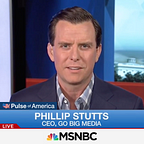This One Industry is Collapsing in Front of Us
I often talk about how we are in the most disruptive time in human history and that political marketers are innovating faster than corporate marketers.
A political marketer’s pace is based on one key factor and the ultimate scorecard — Election Day. It creates a “win or die” mentality and forces speed, innovation and accountability with each and every marketing campaign.
We either disrupt ourselves daily or we are out of business forever.
I have a keen eye on businesses that are innovating but also, those industries that are as slow as a turtle to adapt — and thus dying.
Let’s take a step back and look at one of the first disruptions that killed an industry — the music business.
Over twenty years ago, Napster entered the marketplace and brought more choice and convenience (download one song for free instead of buying an entire CD for $15.99) to the market, but soon enough, it caused the music industry to collapse. While Napster may have caused the disruption, Apple/iTunes created an entirely new economy off the backs of the music industry’s decaying corpse.
The world changed forever.
Which brings us to the next industry that is in the midst of a total and utter collapse — the brick and mortar retail industry.
It’s predicted that 25–30% of all malls will close in the next few years. Fox Business recently reported on the pending “Apocalypse” of the brick and mortar retail economy and the statistics are stunning. Read more about it here.
While e-commerce has been the driver of this Armageddon, many predict that the looming advancement of Virtual Reality and Augmented Reality will be the knockout punch to the brick and mortar retail industry.
And it should scare the hell out of anyone in this space.
My friend Peter Diamandis recently wrote about this, stating: “Already, several big players have broken into the VR market….Walmart filed two VR shopping-related patents. In a new bid to disrupt a rapidly changing retail market, Walmart now describes a system in which users couple their VR headset with haptic gloves for an immersive in-store experience, whether at 3am in your living room or during a lunch break at the office.”
While the VR/AR disruption is happening more rapidly in this industry than others, I also see a gap that might save some of those retailers: Disruptive technology is not building a deeper connection with the customer — yet.
Convenience? Absolutely. But not a human connection.
And therein lies an opportunity for the brick and mortar retailers.
I recently came across one wildly creative solution on how the retail industry has turned this challenge into an opportunity, giving them an opening to grow (while most of their brethren is collapsing).
It’s utterly fascinating + it will inspire you to think creatively about disruption for your business.
Here’s what happened…
Some in the retail brick and mortar industry have repurposed an old idea that technology can’t disrupt — human connection — by opening gourmet sit-down restaurants in their space. And they are partnering with some of the best chef’s in America to do it.
Why? Because they know if you come to their stores, eat a great meal with a friend and drink some wine or coffee, then you are much more likely to spend a lot of money in that store.
Brilliant.
A great example of this is the uber-successful Chicago restauranteur (and CEO/Creative Director of Hogsalt Hospitality, a Chicago-based restaurant group), Brendan Sodikoff. He partnered with Restoration Hardware to open RH Rooftop Restaurant — inside its New York-based retail outlet.
Why did Sodikoff take a chance on a dying industry? He succinctly put it this way: “I open restaurants when there’s something I want to experience that doesn’t already exist nearby.”
That’s the brain of an innovative marketer. Study this guy.
So, the battle lines are drawn and the question now for retailers is:
- What will consumers choose? And who will win?
- Will the e-comm/AR/VR “convenience” marketing model kill physical retail or can “human connection” in-store marketing save it?
It’s obvious that e-commerce is only getting bigger and VR/AR retail is inevitable. But it all lacks a connective fiber. So don’t count out the strategy of marketing to human connection to save the what’s left of the physical retail industry.
Those that do, will flourish. Those that don’t, will die.
Here is what you can learn from this:
- 95% of our economy will be disrupted in the next 5–10 years. Bank on it. Brendan Sodikoff’s advice is the right one — focus your business’ marketing and experience on areas that won’t be disrupted. The obvious one is building deeper connections with your customer base. If you focus on that alone, you are moving in the right direction. But what other ways can you innovate as an outlier?
- Too overwhelmed by the amount of disruption occurring? Not sure how to take your head out of the sand and move forward? My advice is to make it easy: Start with a meeting every two weeks with your team where you brainstorm innovative ideas and easy ways to implement them. Get some initial wins on the board, and it will change your mindset and thrust you forward.
P.S. — What hasn’t Lieutenant Commander Chip Lutz accomplished? He’s a retired Navy officer, the president and founder of UNConventionalLeader, a seasoned educator, and author of five books. We sat down to discuss leadership and everything that comes with it, here on his Leadership Happy Hour podcast: https://apple.co/2MEuxoM
P.P.S. — If you know of a friend or a colleague that would enjoy my bi-weekly updates about incredibly cool, funny and idiotic marketing ideas, please forward this piece to them and tell them to subscribe by emailing me — (ps@phillipstutts.com) or signing up at PhillipStutts.com.
